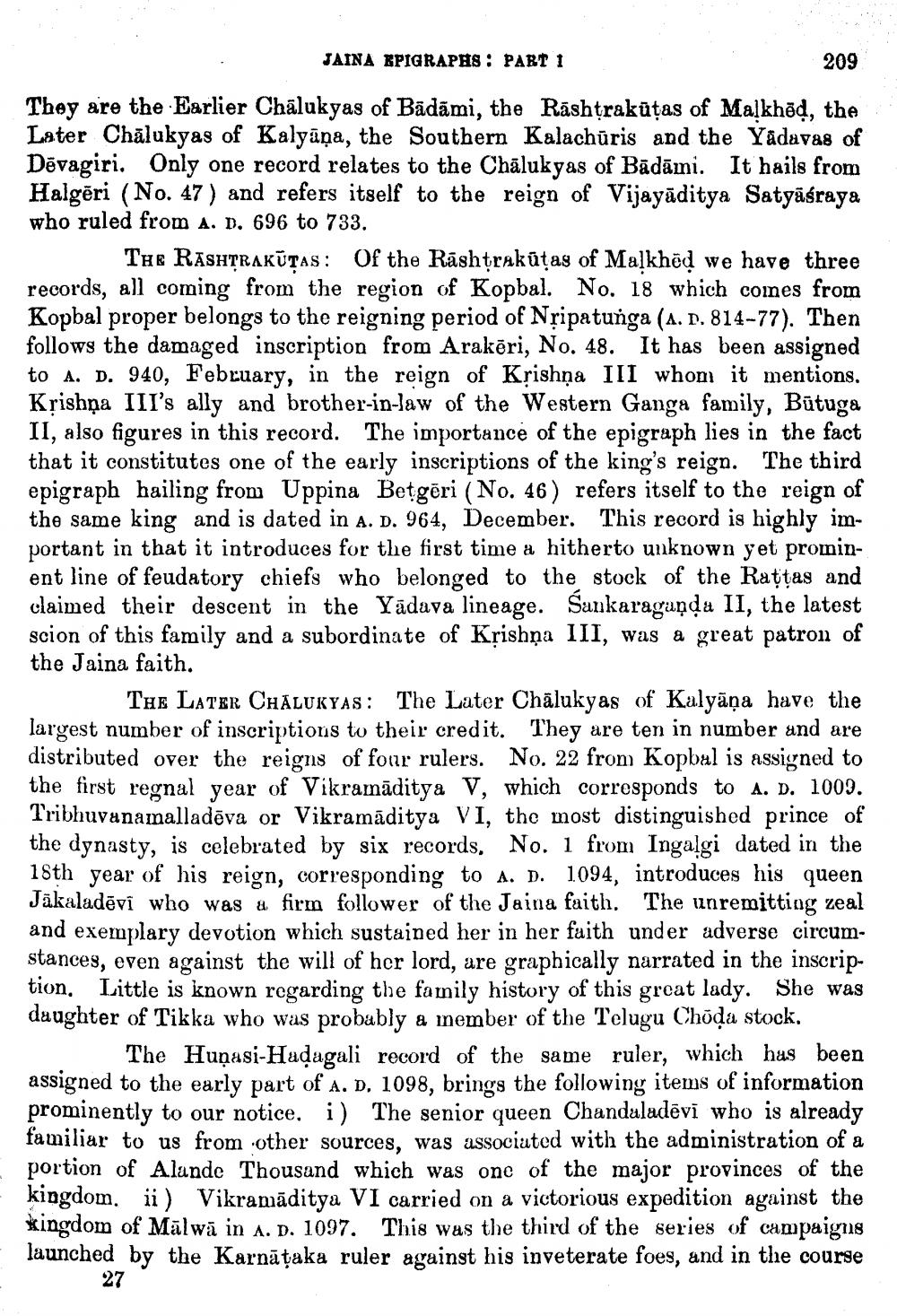________________
JAINA EPIGRAPHS : PART 1
209
They are the Earlier Châlukyas of Bādāmi, the Rashtrakūtas of Malkhôd, the Later Chālukyas of Kalyāņa, the Southern Kalachūris and the Yadavas of Dēvagiri. Only one record relates to the Chālukyas of Bādāmi. It hails from Halgēri (No. 47 ) and refers itself to the reign of Vijayāditya Satyäśraya who ruled from A. D. 696 to 733.
The RASHRakūȚAs: Of the Rashtrakūtas of Maļkhēd we have three records, all coming from the region of Kopbal. No. 18 which comes from Kopbal proper belongs to the reigning period of Nřipatunga (A. D. 814-77). Then follows the damaged inscription from Arakēri, No. 48. It has been assigned to A. D. 940, February, in the reign of Krishņa III whom it mentions. Krishna III's ally and brother-in-law of the Western Ganga family, Būtuga II, also figures in this record. The importance of the epigraph lies in the fact that it constitutes one of the early inscriptions of the king's reign. The third epigraph hailing from Uppina Betgēri (No. 46) refers itself to the reign of the same king and is dated in A. D. 964, December. This record is highly important in that it introduces for the first time a hitherto unknown yet prominent line of feudatory chiefs who belonged to the stock of the Rattas and claimed their descent in the Yadava lineage. Sankaraganda II, the latest scion of this family and a subordinate of Krishņa III, was a great patron of the Jaina faith.
The Later CHĀLUKYAS: The Later Chālukyas of Kalyāṇa have the largest number of inscriptions to their credit. They are ten in number and are distributed over the reigns of four rulers. No. 22 from Kopbal is assigned to the first regnal year of Vikramāditya V, which corresponds to A. D. 1009. Tribhuvanamalladēva or Vikramāditya VI, the most distinguished prince of the dynasty, is celebrated by six records, No. 1 from Ingalgi dated in the 18th year of his reign, corresponding to A. D. 1094, introduces his queen Jākaladēvi who was a firm follower of the Jaina faith. The unremitting zeal and exemplary devotion which sustained her in her faith under adverse circumstances, even against the will of her lord, are graphically narrated in the inscription. Little is known regarding the family history of this great lady. She was daughter of Tikka who was probably a member of the Telugu Choda stock.
The Huñasi-Hudagali record of the same ruler, which has been assigned to the early part of A. D. 1098, brings the following items of information prominently to our notice. i) The senior queen Chandaladēvī who is already familiar to us from other sources, was associated with the administration of a portion of Alande Thousand which was one of the major provinces of the kingdom. ii) Vikramāditya VI carried on a victorious expedition against the kingdom of Mālwă in A. D. 1097. This was the third of the series of campaigns launched by the Karnāțaka ruler against his inveterate foes, and in the course
27




